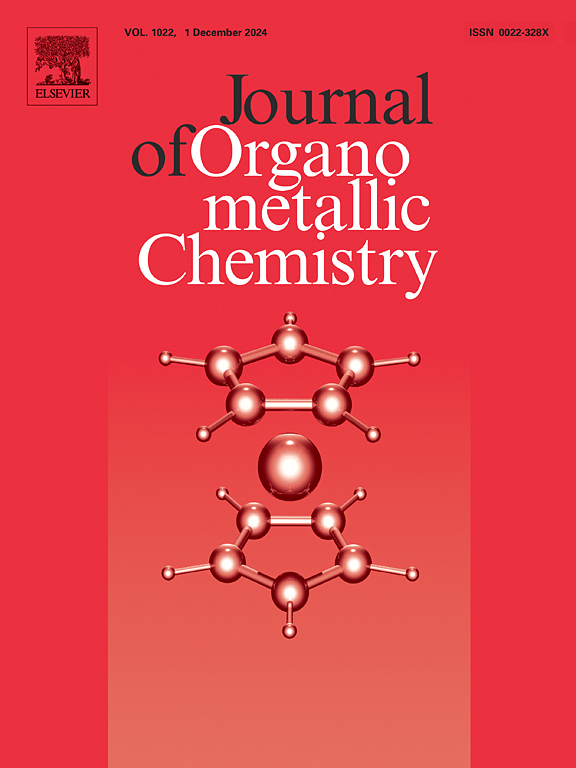A new class of silatranes derived from nitrilotris(methylenephenylphosphinic) acid
IF 2.1
3区 化学
Q3 CHEMISTRY, INORGANIC & NUCLEAR
引用次数: 0
Abstract
Reactions of a series of trichlorosilanes RSiCl3 (R = Me, tBu, Bn, Ph, Vi, Cl) and the tris(trimethylsilyl) derivative of nitrilotris(methylenephenylphosphinic) acid (NTPA(SiMe3)3) proceeded with transsilylation (release of Me3SiCl) and afforded the respective silatrane-like cage compounds of the type N(CH2P(=O)(Ph)O)3SiR (NTPA(SiR), R = Me, tBu, Bn, Ph, Vi, Cl). According to single-crystal X-ray diffraction analyses (for R = Me, tBu, Bn, Ph, Vi) and DFT analyses (R = Me, Cl), these compounds accommodate [4+1]-coordinate Si atoms in a capped tetrahedral coordination sphere. The environment of the N atom is trigonal pyramidal, with the lone pair pointing toward the Si atom with N⋅⋅⋅Si distances in the range of 2.7451(12) Å (R = Bn) to 2.827(5) Å (R = tBu). For R = Cl, N⋅⋅⋅Si distances were calculated at the PBE0 level to be 2.748 Å in the isolated molecule, 2.620 Å in a chloroform solvate of the type NTPA(SiCl)(HCCl3)3. Analyses of the Intrinsic Bond Orbitals (IBOs) and Natural Localized Molecular Orbitals (NLMOs) revealed polarization of the N-located lone pair toward Si, with only marginal orbital contribution of the Si atom in the resultant NLMO (ca. 1.4% for R = hydrocarbyl, 2.2% for R = Cl, 3.3% for R = Cl(HCCl3)3).

从氮三(亚甲基苯基膦酸)衍生出的一类新型硅烷
一系列三氯硅烷 RSiCl3(R = Me、tBu、Bn、Ph、Vi、Cl)和氮基三(亚甲基苯基膦)酸的三(三甲基硅)衍生物(NTPA(SiMe3)3)发生了反式硅烷化反应(释放出 Me3SiCl),并得到了相应的 N(CH2P(=O)(Ph)O)3SiR(NTPA(SiR),R = Me、tBu、Bn、Ph、Vi、Cl)型硅烷基笼状化合物。根据单晶 X 射线衍射分析(R = Me、tBu、Bn、Ph、Vi)和 DFT 分析(R = Me、Cl),这些化合物的四面体配位层中含有 [4+1] 配位的硅原子。N 原子的环境呈三叉金字塔形,孤对指向硅原子,N⋅⋅⋅Si 间距在 2.7451(12) Å(R = Bn)到 2.827(5) Å(R = tBu)之间。对于 R = Cl,在 PBE0 水平上计算出的 N⋅⋅Si 距离在孤立分子中为 2.748 Å,在 NTPA(SiCl)(HCCl3)3 型氯仿溶液中为 2.620 Å。对固有键轨道 (IBO) 和天然局域分子轨道 (NLMO) 的分析表明,位于 N 位置的孤负对向硅极化,在由此产生的 NLMO 中,硅原子的轨道贡献微不足道(R = 碳氢基时约为 1.4%,R = Cl 时约为 2.2%,R = Cl(HCCl3)3 时约为 3.3%)。
本文章由计算机程序翻译,如有差异,请以英文原文为准。
求助全文
约1分钟内获得全文
求助全文
来源期刊

Journal of Organometallic Chemistry
化学-无机化学与核化学
CiteScore
4.40
自引率
8.70%
发文量
221
审稿时长
36 days
期刊介绍:
The Journal of Organometallic Chemistry targets original papers dealing with theoretical aspects, structural chemistry, synthesis, physical and chemical properties (including reaction mechanisms), and practical applications of organometallic compounds.
Organometallic compounds are defined as compounds that contain metal - carbon bonds. The term metal includes all alkali and alkaline earth metals, all transition metals and the lanthanides and actinides in the Periodic Table. Metalloids including the elements in Group 13 and the heavier members of the Groups 14 - 16 are also included. The term chemistry includes syntheses, characterizations and reaction chemistry of all such compounds. Research reports based on use of organometallic complexes in bioorganometallic chemistry, medicine, material sciences, homogeneous catalysis and energy conversion are also welcome.
The scope of the journal has been enlarged to encompass important research on organometallic complexes in bioorganometallic chemistry and material sciences, and of heavier main group elements in organometallic chemistry. The journal also publishes review articles, short communications and notes.
 求助内容:
求助内容: 应助结果提醒方式:
应助结果提醒方式:


